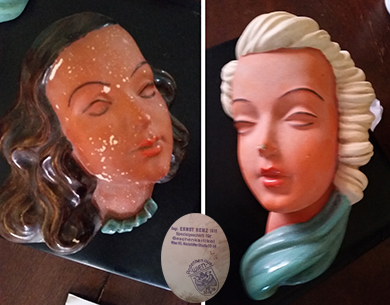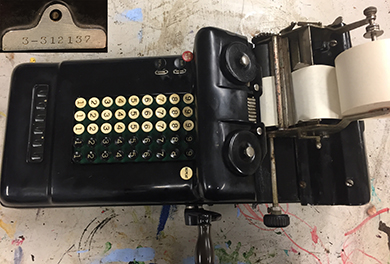 |
|
|||
 |
 |
|||
RINKER ON COLLECTIBLES — Column #1641 Copyright © Harry Rinker, LLC 2018 Questions
and Answers
QUESTION: I have two wall masks of young women. The first wall mask is numbered 127, faces left, has whitish-blonde hair, and is wearing a turquoise scarf. The second wall mask is numbered 133, faces right, and has brown hair. Both are stamped on the bottom: “Begr. ERNST RENZ 1876 / Spezialgeschäft für / Geschenkartikel / Wien VII, Marishilfer Straße 12-18” beneath which is a shield inside of which is the double headed Austrian eagle and above the shield “Andenken aus” in an arch above “WIEN.” I searched online for the history behind the masks to see if they were worth anything. I did not find any information. What information can you provide? – D. B., Email Question 
ANSWER: The key to researching any object is knowing the correct question to ask. Try doing a Google search for “1950s Austrian female wall masks.” You will find dozens of images for masks similar to the ones you own. The concept of female beauty was redefined following World War II. Idealized images of women appeared as figurines and wall plaques. There also was an element of exoticism due to the emphasis on Asian, African, and Polynesian faces and bodies. Ceramic manufacturers in Austria and West Germany were responsible for many of these pieces. Since these face masks were an extension of German Retro pottery, which I collect, I purchased a copy of Horst Makus’s “Wall Masks of the 1950s: Beautiful and Exotic,” published by Arnoldsche in 2000 with text in German and English, during a visit to Germany. Many of the manufacturers of wall masks also made other pottery forms. Adolf Prischl (January 24, 1912 to June 7, 1970) designed both your masks. He was born in Vienna. In 1929, he began his studies at the Wienerberger Werkstättenschule für Keeramik where he studied under Robert Obsieger. Prischl remained an extra year, completing his studies in 1932. The school was closed in 1934. Several masks and figurines designed by Prischl were produced by Goldscheider and Keramos Wiener Kunstkeramik und Porzellanmanufackur. Prischl served in the German military from 1940 to 1942. From 1943 to 1946 he worked for Keramos Wiener Kunstkeramik und Porzellanmanufaktur. In 1947, Prischl received his master’s certificate as a potter and ceramist and shortly thereafter opened his own workshop in Vienna’s 5th District, only to move it later to Mollardgasse in the 6th District. Kunstkeramik Adolf Prischl made a wide range of decorative and utilitarian objects. In addition, it produced the work of other ceramic designers such as Stephan Dakon’s masks and Victor Matula’s animal figures. When the Goldscheider trademarks passed to Majolikafabrik Tönnieshof Gmbh Ernst & Christian Carsten in Fredelsloh, Prischl created masks similar in design to those made by Goldscheider. When Karl Sailer became a partner, the firm was renamed Kunstkeramik Prischl & Sailer. When Carstens ceased production of the Goldscheider wall masks, Prischl & Sailer obtained the molds. By the mid-1960s, public taste moved away from the Austrian-German retro style. Prischl closed his company in 1965. He worked for Pawlata, a Vienna ceramic firm, until his death in 1970. Mask #127 is 13 cm wide by 22 cm high. Mask #133 measures 20 cm by 18 cm. Carstens made a smaller version of the second mask. It is numberd “533” and measures 18 cm by 12 cm. The stamp on the bottom of your masks is the Vienna gift shop from which they were purchased. “Andenken aus Wien” translates to “Souvenir from Vienna.” The perceived value of the manufacturer, the theme of the face, and quality are the key elements in valuing 1950s Austrian and German wall masks. Goldscheider is the magic name. African subjects command more than the standard European beauty. Masks designed by Prischl for Goldscheider sell between $150.00 and $225.00. Masks designed and manufactured for his own firm bring less. I checked WorthPoint.com using “sale date” rather than “best” match. I wanted a sense of how prices have fared over the past five years. As I suspected, prices are decreasing. Like so many antiques and collectibles specialized collecting categories, 1950s Austrian and German wall masks experienced a collecting craze. The craze started in the mid-1990s and ended by 2008. A fair secondary market retail value for each of your two wall masks is between $65.00 and $80.00. As always, the key is to find a buyer who understands what they are and wants to add them to his/her collection. QUESTION: While antiquing in a small town in Texas, I acquired a framed large photograph of Camp Lewis. The photograph is almost a yard long. The label on the paper backing reads “The Dayton Company [in script] / PICTURE GALLERIE / MINNEAPOLIS.” I would like to know if it is one-of-a-kind, time frame of the image, and value. BH, Email Question 
ANSWER: Your photograph is not one-of-a-kind. It was a souvenir product designed to be sold to troops who trained at Fort Lewis during World War I and the years immediately following the war. Your example was purchased by a soldier or family member of a soldier from Minnesota who took it to the picture gallery at Dayton’s in Minneapolis and had it framed. Now Fort Lewis, Camp Lewis was located on the Nisqually Plain in southern Pierce County, just south of Tacoma, Washington. Construction began in 1916. On July 8, 1917, the base was named Fort Lewis to honor Meriwether Lewis of the Lewis and Clark expedition. The base opened on September 5, 1917. Captain David C. Stone (later Major General and commander of the base) and two civilians, planner Carl F. Plat and engineer W. J. Roberts, directed the construction of the base. A U shape (horseshoe shape) was selected. By November 11, 1917, the base population reached 45,000. The base was home to the Ninety-First Division, known as the Wild West Division, who trained there before heading to France. When the Ninety-First left, the Thirteenth Division began training. The war ended before the training of the Thirteenth Division was completed. The Thirteenth Division was dissolved. Camp Lewis went into decline. Some county officials wished to take the land. A massive 1927 building program at Camp Lewis ended the discussion. Camp Lewis became Fort Lewis. For a detailed history of “Camp Lewis,” see www.historylink.org/File/8455. Yard long “military base” pictures have a history extending back to the early 20th century. Size varies. Their secondary market value is governed by location, military unit, and individuals portrayed. In addition to your yard long photograph of the camp, yard long photographs exist for the units that trained at Camp Lewis. Your camp photograph has a realistic secondary market value between $35.00 and $45.00. I have seen similar photographs that were priced higher in antiques and collectibles malls and shops. The fact that I saw them means they had not sold. When not local, these images are more a decorative/nostalgic than a collecting buy. Unless there is something special about them, World War I yard long photographs of soldier units sell between $20.00 and $30.00. QUESTION: I have a Burroughs Class 3 adding machine that is in working order. I am moving and need to sell it. What price should I ask? – LA, Reading, PA, Email Question 
ANSWER: In the past when someone asked me about one of these old clunker adding machines, my stock response was: “Do you have a boat? They make great boat anchors.” Although this still is the most logical answer, there is reason to pause. The Burroughs Class 3 adding machine is manually operated, has a black painted metal frame and a green metal keyboard, and is equipped with five columns of black and white plastic keys. It has a non-add and subkeys. The crank is on the right. A black ribbon printing mechanism is behind the keyboard. The tape is visible to the user. As the years progressed, Burroughs continually updated the machine. Your machine is one of the earliest examples. Asking prices (far different from the selling price) for the Burroughs Class 3 adding machine are all over the place. Checking recent sell-through prices on Worthpoint.com, values for 2016 through 2018 range from $28.00 to $120.00. Buyers are decorators not collectors. Accounting firms love to display one of these old machines in their lobby as a conversation piece. A realistic secondary market value is between $35.00 and $45.00. Finding someone willing to pay that will be a challenge. “Do you own a boat?” Harry L. Rinker welcomes questions from readers about
collectibles, those mass-produced items from the twentieth and twenty-first centuries.
Selected letters will be answered in this column.
Harry cannot provide personal answers.
Photos and other material submitted cannot be
returned.
Send your questions to: Rinker on Collectibles, 5955 Mill
Point Court SE, Kentwood, MI 49512.
You also can e-mail your questions to
harrylrinker@aol.com.
Only e-mails containing a full name and mailing address
will be considered.
You can listen
and participate in
WHATCHA GOT?, Harry’s
antiques and collectibles radio call-in show, on Sunday mornings between 8:00 AM
and 10:00 AM Eastern Time.
If you
cannot find it on a station in your area,
WHATCHA GOT?
streams live on the Internet at www.gcnlive.com.
|
||||